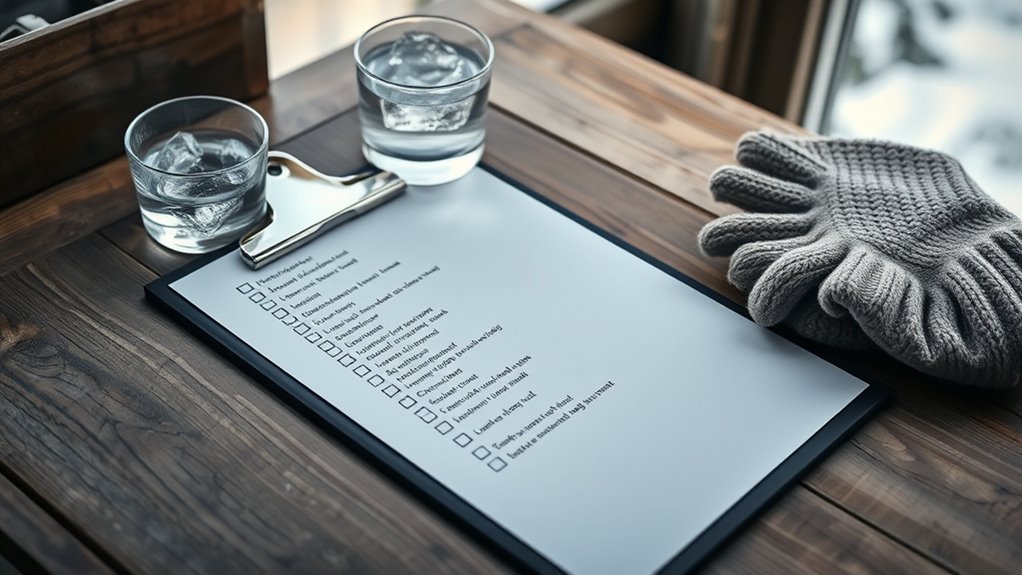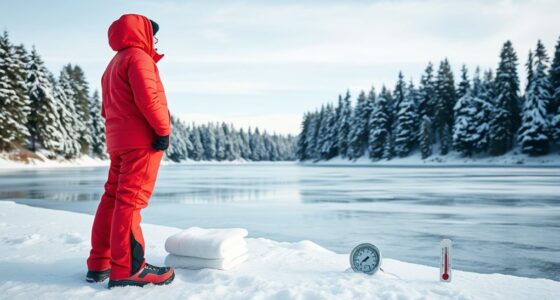Before starting cold exposure, make certain you’re aware of safety measures such as avoiding practice alone and keeping warm gear nearby. Begin gradually, with short sessions of 30 seconds to a minute, and increase slowly as your body adapts. Choose a safe environment with a non-slip surface, wear minimal clothing, and listen carefully to your body’s signals. Prioritize safety over speed and know signs of hypothermia or shock. For detailed steps to build your routine safely, continue exploring essential protocols.
Key Takeaways
- Confirm safety measures and avoid practicing alone in unfamiliar or unsafe environments.
- Start with short exposures (30 seconds to 1 minute) and gradually increase duration.
- Use safe, non-slip surfaces and minimal clothing to prevent injury and maximize benefits.
- Monitor body signals closely; stop immediately if experiencing numbness, dizziness, or excessive cold.
- Establish a consistent routine, educate yourself on proper techniques, and prioritize patience and safety.
Getting Started Safely With Cold Exposure

If you’re new to cold exposure, it’s important to start slowly and listen to your body. Jumping right into intense cold can be overwhelming and risky, especially if you haven’t developed your body’s cold adaptation yet. Begin with short durations and gradually increase exposure time as your body becomes more accustomed to the cold. This approach helps your body adapt safely and reduces the chances of shock or hypothermia. Remember, your goal is to build resilience gradually, so patience is key.
Before you start, confirm you’re aware of necessary safety precautions. Never expose yourself alone in unfamiliar or unsafe environments, and always have a way to get help if needed. Keep a warm blanket or clothing nearby, and don’t push yourself beyond discomfort. If you start feeling numb, dizzy, or excessively cold, it’s time to cut the session short. Always listen to your body’s signals—pain, numbness, or shivering that feels uncontrollable are signs you need to stop immediately.
It’s also wise to consult with a healthcare professional before beginning any cold exposure routine, especially if you have underlying health conditions like cardiovascular issues or circulation problems. They can provide personalized advice and help ensure you’re practicing safely. Additionally, educate yourself on basic cold adaptation techniques. For instance, begin with cold showers or splash cold water on your face and wrists to initiate your cold adaptation process. These small steps help your body gradually get used to colder temperatures without causing undue stress.
Make sure your environment is safe—use a clean, non-slip surface, and avoid icy or overly cold water that might cause shock. When practicing cold exposure, start with brief intervals, such as 30 seconds to a minute, and slowly extend them over time. Wear minimal clothing during cold exposure, but ensure you’re not risking frostbite or excessive discomfort. Using proper timing and clothing can optimize benefits while maintaining safety.
Finally, always prioritize safety over speed. Cold exposure can be a powerful tool for health, but only if done responsibly. Establish a routine, monitor how your body responds, and adapt accordingly. Consistency and caution will help you reap the benefits of cold adaptation without risking your well-being. Remember, the goal is to safely build resilience to cold, not to push yourself to the point of harm. Being aware of cold adaptation principles can further enhance your approach and results.
Frequently Asked Questions
Can Cold Exposure Improve Mental Clarity?
Cold exposure can markedly improve your mental clarity by boosting mental sharpness and focus enhancement. When you expose yourself to cold, your body releases endorphins and increases blood flow to your brain, sharpening your awareness. This heightened state of alertness helps you think more clearly and stay focused longer. Regular cold exposure trains your brain to handle stress better, ultimately leading to improved cognitive function and sharper mental clarity over time.
How Often Should Beginners Practice Cold Exposure?
You should start with cold exposure a few times a week to build your cold tolerance gradually. Typically, 2-3 sessions weekly are effective for beginners, allowing your body to adapt without overdoing it. Consistent exposure helps improve your cold tolerance and mental resilience. Remember, listen to your body, and increase frequency slowly as you become more comfortable. This approach maximizes benefits while minimizing risks.
Are There Any Medical Conditions That Contraindicate Cold Exposure?
You should avoid cold exposure if you have medical restrictions or contraindicated conditions like cardiovascular issues, hypertension, Raynaud’s disease, or certain skin conditions. These conditions can worsen with cold exposure, risking health complications. Always consult your healthcare provider before starting cold exposure routines, especially if you have any health concerns. If your doctor advises against it, respect their guidance to prevent adverse effects and guarantee your safety.
What Are the Signs of Overexposure or Hypothermia?
Watch for warning signs of overexposure or hypothermia, like shivering, slurred speech, sluggish movements, and numbness. Cold exposure risks escalate if you experience confusion, dizziness, or intense exhaustion. If body temperature drops dangerously low, you may develop pale or blue skin, slow heartbeat, or loss of consciousness. Recognizing these signs early helps prevent serious health hazards, so always stay alert during cold exposure and seek warmth quickly.
How Should I Warm up After Cold Exposure Sessions?
After cold exposure, you should use warming techniques like gradually increasing your body temperature with warm clothing, a hot shower, or a heating pad. Recovery strategies include gentle movement to boost circulation and sipping warm fluids. Avoid sudden, intense heat to prevent shock. Focus on slow, steady warming to safely restore your body’s warmth and guarantee a safe, effective recovery from the cold session.
Conclusion
Now that you’ve learned the basics, you’re ready to explore cold exposure safely. But remember, the journey isn’t over—there’s more to discover about how your body responds and adapts. Are you prepared to push your limits and unseal new benefits? Stay vigilant, listen to your body, and keep your curiosity alive. The cold holds secrets that could transform your health—are you ready to reveal them? The next step awaits…









